COLOMBIA
History

History
History
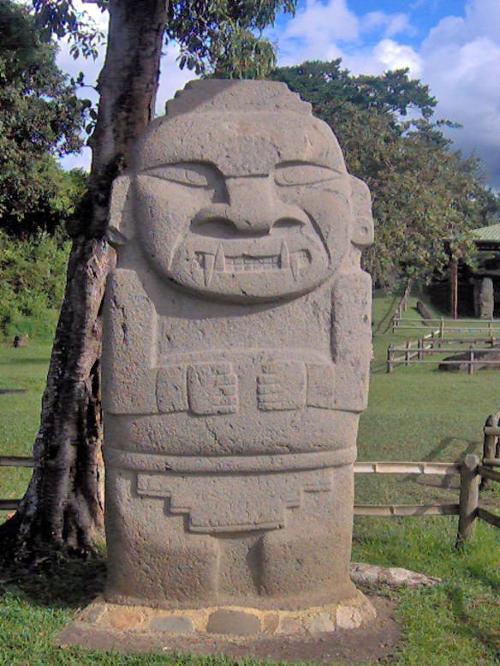 San Ausustin Culture ColombiaPhoto: Luis Carlos Alvarado in the public domain
San Ausustin Culture ColombiaPhoto: Luis Carlos Alvarado in the public domain
In the pre-Columbian era, the land was inhabited by peoples with different levels of civilisation and organisation. The oldest remains of human habitation found date back more than 16,000 years. Early Pre-Columbian peoples included Urabá and Sinú in the north and Tumaco, Calima Malagana, Cauca and San Agustín in the southwest. The Spanish were the first to land on the Colombian coast in 1500.
Under the leadership of Gonzalo Jiménez de Quesada and Sebastián de Belalcázar, the current Colombia was discovered in 1536. By 1810, revolutionary and independence ideas were spreading from Europe to the South American continent subject to the Spanish crown. The Criollo (white descendants of Spaniards born in America) lived in increasing resentment of the privileged position of the Spanish-born elite of peninsulares. Mestizos (half Spanish, half indigenous) were considered second class citizens and the rights of indigenous and black people were practically equal to those of a slave.
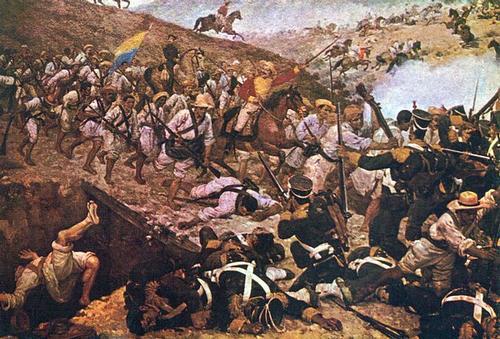
After the proclamation of independence (1810), the Criollos (Bolí var, San Martín and Sucre) waged a series of revolutions over large parts of the continent against the army of the Spanish king and the peninsulares, who represented the crown in Latin America. The war was fought mainly by mestizo, indigenous and black soldiers, who were hardly victorious. In 1819, the Republic of Great Colombia was founded in the northern part of South America with Simón Bolivar as president.
Venezuela and Ecuador separated from Great Colombia in 1830 and Panama in 1903. The 19th century was characterised by a constant struggle between two movements that alternated in power: the Conservatives and the Liberals. This was accompanied by numerous violent social and political conflicts that culminated in the "War of a Thousand Days" (1899-1902). This internal conflict cost the lives of more than 100,000 Colombians.
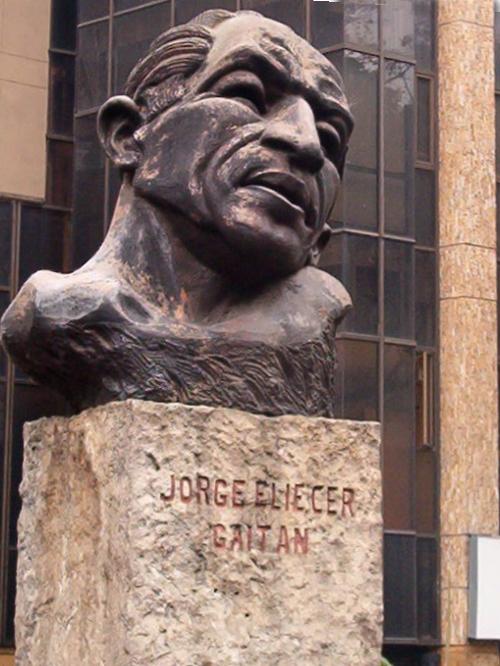 Jorge Eliecer Gaitan Colombia hoto: Glasperlenspiel CC 2.5 Generic no changes made
Jorge Eliecer Gaitan Colombia hoto: Glasperlenspiel CC 2.5 Generic no changes made
The subsequent calm period came to an end when the Liberal leader Jorge Eliécer Gaitán was assassinated in 1948. This reignited the civil war between conservatives and liberals. The period 1948-1958, known as "La Violencia" (the Violent Period), claimed between 80,000 and 400,000 victims, according to estimates. In 1958, a political agreement was reached, according to which Conservatives and Liberals would alternate in government and share important administrative functions. This system of government was called the Frente Nacional (National Movement).
However, the Frente Nacional governments did not put a structural end to the violence. On the contrary, because of this gentlemen's agreement between the tops of both parties, many felt excluded from having any real influence on political decision-making. On the one hand, this led to the emergence of a large number of leftist revolutionary movements, while in the rural areas the struggle between liberals and conservatives continued. In the coffee and colonisation regions, local conflicts over land and trade monopolies were dominated by violent criminal organisations. At the same time, local authorities, landowners and industrialists created private armies in their fight against revolutionary and criminal groups. These often developed into paramilitary groups.
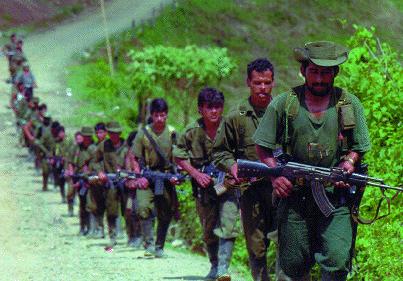 Farc Fighters ColombiaPhoto: Public domain
Farc Fighters ColombiaPhoto: Public domain
Thus, the 1960s saw the emergence of the conflict that still continues today, with the Ejército de Liberación Nacional (ELN 1962), the Fuerzas Armadas Revolucionarias de Colombia (FARC 1964), and towards the end of the 1980s the paramilitaries (the latter often operating in cooperation with the army and police against the common enemy: the guerrilla) playing the main roles. In the 1980s, criminal activities, the production and trafficking of cocaine, extortion and kidnapping became the main sources of income for the illegal armed groups. The mix of revolutionary, mafia and paramilitary organisations makes Colombia one of the most violent countries in the world. It is estimated that about 25,000 murders take place every year, of which at least 5,000 are politically motivated. The two largest guerrilla groups, FARC and ELN, together have less than 20,000 armed fighters. The paramilitaries were united in the late 1990s in the Autodefensas Unidas de Colombia (AUC) and have more than 10,000 men under arms.
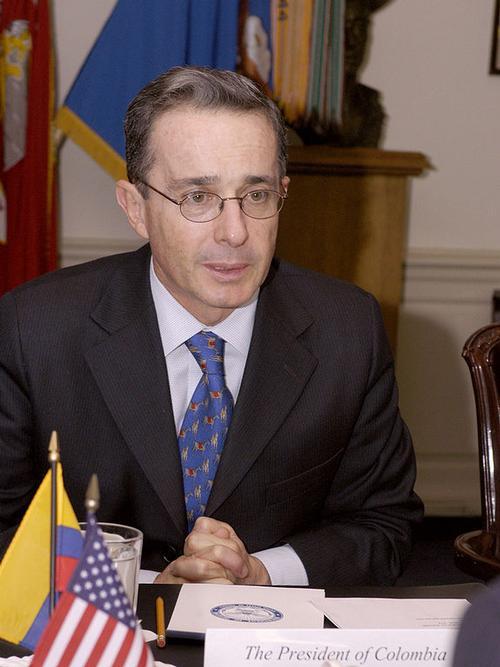
Currently, two projects are in place to curb coca production and contain the terrorism of the guerrilla groups:
Plan Colombia, officially in operation since 1999. This project, which receives major support from the US government, seeks to destroy coca plantations by spraying from aircraft. A second Plan Colombia was presented by the Uribe government in January 2007.
The Uribe government's peace process, verified by the OAS (Organization of American States) since late 2003. The peace process consists of a demobilisation programme based on the "Justicia y Paz" law, as well as a National Commission for Satisfaction and Reconciliation. For now, only the (now former) AUC (paramilitaries) have entered the peace process. The approach has many supporters but there is also much opposition. In September 2006, there seemed to be an opportunity to negotiate with the FARC. Since a bomb explosion at the military academy in October 2006 (which, incidentally, was never claimed), this development has come to a standstill.
In 2007, Hugo Chavez, the President of Venezuela, played a mediating role in the struggle for the release of FARC prisoners. The main success is the release of Clara Rojas and Consuelo Gonzalez.
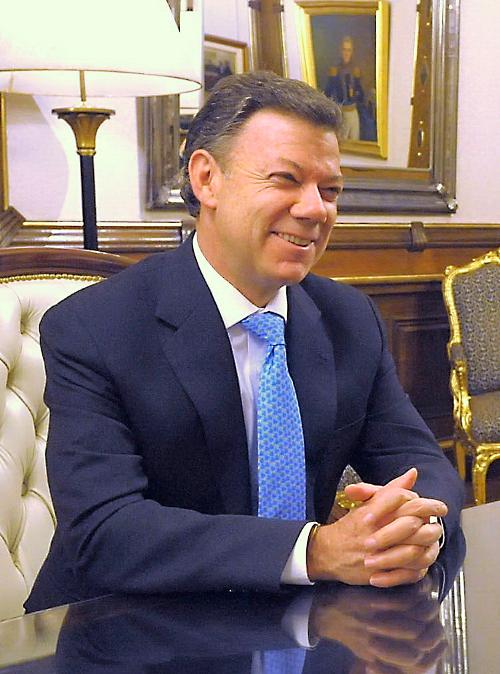 President Santos ColombiaPhoto: Presidencia de la Nación Argentina CC 2.0 Generic no changes made
President Santos ColombiaPhoto: Presidencia de la Nación Argentina CC 2.0 Generic no changes made
In 2008, the hunt for the FARC intensifies, a conflict with Ecuador arises as troops cross the border. In July 2008, there is a huge success. Government forces free Ingrid Betancourt, the former presidential candidate who had been a prisoner in the jungle for six years. In March 2009, the FARC releases the last foreign hostage. President Uribe offered peace talks if the FARC would agree to a ceasefire and refrain from "criminal activities". In March 2010, Uribe tries to change the constitution so that he can be re-elected for a third time. The plan failed and in June 2010, the presidential elections were won by Juan Manuel Santos, the former minister of defence. The FARC is best known in the Netherlands for the participation of Tanja Nijmeijer. In November 2012 she took part in negotiations between the government and the FARC in Cuba. In January 2014, President Santos declared that he believes a peace treaty will be signed with the FARC before the end of the year.
In June, Santos is re-elected as president. In the years 2015 and 2016, tough negotiations take place in Havana, Cuba. In August 2016, a ceasefire takes effect and the treaty is signed in September. In October 2016, the population, completely unexpectedly and with a very small majority, says no to the treaty in a referendum. In November, the government signs a revised deal with the FARC and in June 2017 the FARC also formally lays down its arms. In June 2018, Ivan Duque wins the presidential election. In 2019, the COVID-19 pandemic hits hard. In 2021, violently suppressed protests against tax plans and corruption.
Sources
Elmar Landeninformatie
CIA - World Factbook
BBC - Country Profiles
Last updated November 2025Copyright: Team The World of Info